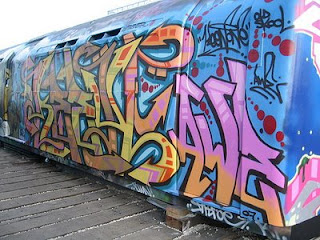Society see's
graffiti as a form of defiance towards them, even though it is a form of
contemporary art. "The first modern graffiti writer is widely considered
to be Cornbread, a high school student from Philadelphia, who in 1967 started
tagging city walls to get the attention of a girl. But it was only in the 1980s
that galleries began to showcase graffiti as artwork." (Melker, Saskia) The places you can
see heavy graffiti culture is New York, Chicago, Philadelphia, and Detroit. There
are many other sites but the area where graffiti is accepted, as a form of art
is Europe. The Europeans do not see graffiti as a form of vandalism; they see
it as a form of art. Back in the 70s you would see graffiti on the Subway trains a lot.
The reasoning the trains were targeted was so the artist work can see all day
wherever the train would travel.
Overseas
owners really don't mind seeing graffiti up on their building walls. They see
it as dead space, why not put up abstract or beautiful artwork up to help the
building stand out. In Toronto, there is a case about whether or not the
graffiti should be taken down or not. They see this as vandalism; the funny
thing is that the owner of the building doesn't mind it being there. It is just
so said that the world casts out graffiti. The only reason it is cast out is
because many misunderstand it. Throughout history society tends to judge things
they can’t nor are willing to understand.
Who are we to
say graffiti isn’t art? Art is like water. I say it is like water because water
is a versatile element it can take the form of anything. Art has many different
forms.
Graffiti
itself has different styles there is not one style, so you can say it's very versatile.
To me I really can't say putting art on a wall that is just abandoned and
taking up space is vandalism. I feel like if its not being used put graffiti up
let the world no only see your artwork but bring life to the area.
If society can't accept
graffiti as a form of art then that means their view on art is one-dimensional.
I would understand how the community would feel if kids just tag places without
asking but if they want to stop it then open up a spot for them. I feel if they
have a place where they can exhibit their graffiti or art they would stay out
of trouble and be more respectful towards the community.
Works Cited
Melker, Saskia. "History Of American Graffiti: From Subway Car to Gallery." PBS. PBS, 31 Mar. 2011. Web. 20 Feb. 2013.
Humber, Larry. "The Art Newspaper." The Art Newspaper. N.p., 07 Nov. 2012. Web. 20 Feb. 2013.



I think the debate of whether graffiti is or is not art will be around for decades to come. For some, it is absolutely art. And, for others, it is a nuisance and a detractor from planned surroundings. For example, I used to live in Reston, in a neighborhood that bordered MS-13 territory. Every time I'd go and walk my dogs, I'd have to pass gang graffiti "marking territory." Graffiti is not always a neutral piece of art: it can be political, social, or even a mark of potential violence.
ReplyDeleteThink about expanding this piece: you make great points here, but be careful about overqualifying groups of people. For example, not all Europeans like or support graffiti, although it is more widespread than in the States. I think a deeper look into the social rationale for graffiti could be warranted here. Sometimes it's beautiful art, as you show above. But other times it's just destruction of property.